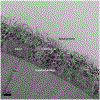Polarized Human Retinal Pigment Epithelium Exhibits Distinct Surface Proteome on Apical and Basal Plasma Membranes
- PMID: 29264809
- PMCID: PMC8785602
- DOI: 10.1007/978-1-4939-7553-2_15
Polarized Human Retinal Pigment Epithelium Exhibits Distinct Surface Proteome on Apical and Basal Plasma Membranes
Abstract
Surface proteins localized on the apical and basal plasma membranes are required for a cell to sense its environment and relay changes in ionic, cytokine, chemokine, and hormone levels to the inside of the cell. In a polarized cell, surface proteins are differentially localized on the apical or the basolateral sides of the cell. The retinal pigment epithelium (RPE) is an example of a polarized cell that performs a variety of functions that are dependent on its polarized state including trafficking of ions, fluid, and metabolites across the RPE monolayer. These functions are absolutely crucial for maintaining the health and integrity of adjacent photoreceptors, the photosensitive cells of the retina. Here we present a series of approaches to identify and validate the polarization state of cultured primary human RPE cells using immunostaining for RPE apical/basolateral markers, polarized cytokine secretion, electrophysiology, fluid transport, phagocytosis, and identification of plasma membrane proteins through cell surface capturing technology. These approaches are currently being used to validate the polarized state and the epithelial phenotype of human induced pluripotent stem (iPS) cell derived RPE cells. This work provides the basis for developing an autologous cell therapy for age-related macular degeneration using patient specific iPS cell derived RPE.
Keywords: Cell surface capturing; Cytokine secretion; Electrophysiology; Fluid transport; Immunocytochemistry; Monolayer; Phagocytosis; Polarization; Retinal pigment epithelium.
Figures












Similar articles
-
Attainment of polarity promotes growth factor secretion by retinal pigment epithelial cells: relevance to age-related macular degeneration.Aging (Albany NY). 2009 Dec 27;2(1):28-42. doi: 10.18632/aging.100111. Aging (Albany NY). 2009. PMID: 20228934 Free PMC article.
-
Different Effects of Thrombin on VEGF Secretion, Proliferation, and Permeability in Polarized and Non-polarized Retinal Pigment Epithelial Cells.Curr Eye Res. 2015 Sep;40(9):936-45. doi: 10.3109/02713683.2014.964417. Epub 2014 Oct 13. Curr Eye Res. 2015. PMID: 25310246
-
Generation of retinal pigment epithelial cells from small molecules and OCT4 reprogrammed human induced pluripotent stem cells.Stem Cells Transl Med. 2012 Feb;1(2):96-109. doi: 10.5966/sctm.2011-0057. Stem Cells Transl Med. 2012. PMID: 22532929 Free PMC article.
-
Plasma membrane protein polarity and trafficking in RPE cells: past, present and future.Exp Eye Res. 2014 Sep;126:5-15. doi: 10.1016/j.exer.2014.04.021. Exp Eye Res. 2014. PMID: 25152359 Free PMC article. Review.
-
Directional protein secretion by the retinal pigment epithelium: roles in retinal health and the development of age-related macular degeneration.J Cell Mol Med. 2013 Jul;17(7):833-43. doi: 10.1111/jcmm.12070. Epub 2013 May 11. J Cell Mol Med. 2013. PMID: 23663427 Free PMC article. Review.
Cited by
-
A Role for βA3/A1-Crystallin in Type 2 EMT of RPE Cells Occurring in Dry Age-Related Macular Degeneration.Invest Ophthalmol Vis Sci. 2018 Mar 20;59(4):AMD104-AMD113. doi: 10.1167/iovs.18-24132. Invest Ophthalmol Vis Sci. 2018. PMID: 30098172 Free PMC article.
-
Cell-autonomous lipid-handling defects in Stargardt iPSC-derived retinal pigment epithelium cells.Stem Cell Reports. 2022 Nov 8;17(11):2438-2450. doi: 10.1016/j.stemcr.2022.10.001. Epub 2022 Oct 27. Stem Cell Reports. 2022. PMID: 36306781 Free PMC article.
-
Autophagy in Age-Related Macular Degeneration: A Regulatory Mechanism of Oxidative Stress.Oxid Med Cell Longev. 2020 Aug 8;2020:2896036. doi: 10.1155/2020/2896036. eCollection 2020. Oxid Med Cell Longev. 2020. PMID: 32831993 Free PMC article. Review.
-
Polarity and epithelial-mesenchymal transition of retinal pigment epithelial cells in proliferative vitreoretinopathy.PeerJ. 2020 Oct 20;8:e10136. doi: 10.7717/peerj.10136. eCollection 2020. PeerJ. 2020. PMID: 33150072 Free PMC article.
-
Retinal pigment epithelium polarity in health and blinding diseases.Curr Opin Cell Biol. 2020 Feb;62:37-45. doi: 10.1016/j.ceb.2019.08.001. Epub 2019 Sep 10. Curr Opin Cell Biol. 2020. PMID: 31518914 Free PMC article. Review.
References
-
- Strauss O (2005) The retinal pigment epithelium in visual function. Physiol Rev 85 (3):845–881 - PubMed
-
- Chiba C (2014) The retinal pigment epithelium: an important player of retinal disorders and regeneration. Exp Eye Res 123:107–114 - PubMed
-
- Reichhart N, Strauss O (2014) Ion channels and transporters of the retinal pigment epithelium. Exp Eye Res 126:27–37 - PubMed
Publication types
MeSH terms
Substances
Grants and funding
LinkOut - more resources
Full Text Sources
Other Literature Sources

